1954
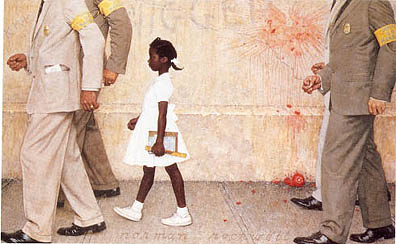 Oliver
Brown v. Board of Education of Topeka, Kansas Oliver
Brown v. Board of Education of Topeka, Kansas
In the 1950s, school segregation was
widely accepted throughout the nation. In fact, it was required by law
in most southern states. In 1952, the Supreme Court heard a number of
school-segregation cases, including Brown v. Board of Education of
Topeka, Kansas. It decided unanimously in 1954 that segregation
was unconstitutional, overthrowing the 1896 Plessy v. Ferguson
ruling that had set the "separate but equal" precedent.

1955
 Montgomery
Bus Boycott Montgomery
Bus Boycott
Rosa Parks, a 43-year-old black
seamstress, was arrested in Montgomery, Alabama, for refusing to give
up her bus seat to a white man. The following night, fifty leaders of
the Negro community met at Dexter Ave. Baptist Church to discuss the
issue. Among them was the young minister, Dr. Martin Luther King, Jr.
The leaders organized the Montgomery Bus Boycott, which would deprive
the bus company of 65% of its income, and cost Dr. King a $500 fine or
386 days in jail. He paid the fine, and eight months later, the
Supreme Court decided, based on the school segregation cases, that bus
segregation violated the constitution.

1957
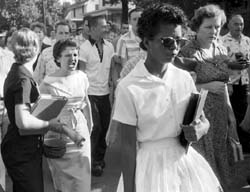 Desegregation
at Little Rock, Arkansas Desegregation
at Little Rock, Arkansas
Little Rock Central High School was to
begin the 1957 school year desegregated. On September 2, the night
before the first day of school, Governor Faubus announced that he had
ordered the Arkansas National Guard to monitor the school the next
day. When a group of nine black students arrived at Central High on
September 3, they were kept from entering by the National Guardsmen.
On September 20, judge Davies granted an injunction against Governor
Faubus and three days later the group of nine students returned to
Central High School. Although the students were not physically
injured, a mob of 1,000 townspeople prevented them from remaining at
school. Finally, President Eisenhower ordered 1,000 paratroopers and
10,000 National Guardsmen to Little Rock, and on September 25, Central
High School was desegregated.

1960
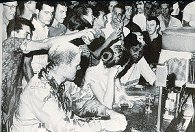 Sit-in
Campaigns Sit-in
Campaigns
After having been refused service at the
lunch counter of a Woolworth’s in Greensboro, North Carolina, Joseph
McNeill, a Negro college student, returned the next day with three
classmates to sit at the counter until they were served. They were not
served. The four students returned to the lunch counter each day. When
an article in the New York Times drew attention to the students’
protest, they were joined by more students, both black and white, and
students across the nation were inspired to launch similar protests.

1961
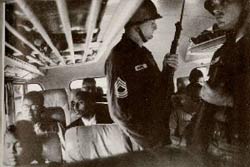 Freedom
Rides Freedom
Rides
In 1961, bus loads of people waged a
cross-country campaign to try to end the segregation of bus terminals.
They nonviolent protest, however, was brutally received at many stops
along the way.

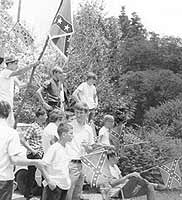 1962 1962
University of Mississippi Riot
President Kennedy ordered Federal
Marshals to escort James Meredith, the first black student to enroll
at the University of Mississippi, to campus. A riot broke out and
before the National Guard could arrive to reinforce the marshals, two
students were killed.

1963
Birmingham
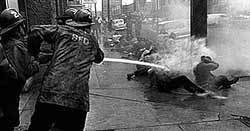 Birmingham,
Alabama was one of the most severely segregated cities in the 1960s.
Black men and women held sit-ins at lunch counters where they were
refused service, and "kneel-ins" on church steps where they
were denied entrance. Hundreds of demonstrators were fined and
imprisoned. In 1963, Dr. King, the Reverend Abernathy and the Reverend
Shuttles worth lead a protest march in Birmingham. The protesters were
met with policemen and dogs. The three ministers were arrested and
taken to Southside Jail. Birmingham,
Alabama was one of the most severely segregated cities in the 1960s.
Black men and women held sit-ins at lunch counters where they were
refused service, and "kneel-ins" on church steps where they
were denied entrance. Hundreds of demonstrators were fined and
imprisoned. In 1963, Dr. King, the Reverend Abernathy and the Reverend
Shuttles worth lead a protest march in Birmingham. The protesters were
met with policemen and dogs. The three ministers were arrested and
taken to Southside Jail.

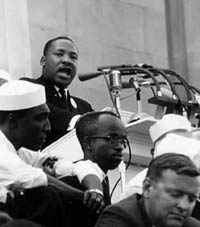 1963 1963
March on Washington
Despite worries that few people would
attend and that violence could erupt, Philip Randolpf and Bayard
Rustin organized the historic event that would come to symbolize the
civil rights movement. A reporter from the Time wrote, "no one
could ever remember an invading army quite as gentle as the two
hundred thousand civil rights marchers who occupied Washington."

1965
Bloody Sunday
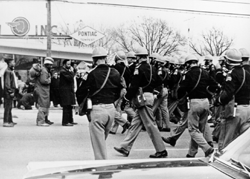 Outraged
over the killing of a demonstrator by a state trooper in Marion,
Alabama, the black community of Marion decided to hold a march. Martin
Luther King agreed to lead the marchers on Sunday, March 7, from Selma
to Montgomery, the state capital, where they would appeal directly to
governor Wallace to stop police brutality and call attention to their
struggle for suffrage. When Governor Wallace refused to allow the
march, Dr. King went to Washington to speak with President Johnson,
delaying the demonstration until March 8. However, the people of Selma
could not wait and they began the march on Sunday. When the marchers
reached the city line, they found a posse of state troopers waiting
for them. As the demonstrators crossed the bridge leading out of
Selma, they were ordered to disperse, but the troopers did not wait
for their warning to be headed. They immediately attacked the crowd of
people who had bowed their heads in prayer. Using tear gas and batons,
the troopers chased the demonstrators to a black housing project,
where they continued to beat the demonstrators as well as residents of
the project who had not been at the march. Outraged
over the killing of a demonstrator by a state trooper in Marion,
Alabama, the black community of Marion decided to hold a march. Martin
Luther King agreed to lead the marchers on Sunday, March 7, from Selma
to Montgomery, the state capital, where they would appeal directly to
governor Wallace to stop police brutality and call attention to their
struggle for suffrage. When Governor Wallace refused to allow the
march, Dr. King went to Washington to speak with President Johnson,
delaying the demonstration until March 8. However, the people of Selma
could not wait and they began the march on Sunday. When the marchers
reached the city line, they found a posse of state troopers waiting
for them. As the demonstrators crossed the bridge leading out of
Selma, they were ordered to disperse, but the troopers did not wait
for their warning to be headed. They immediately attacked the crowd of
people who had bowed their heads in prayer. Using tear gas and batons,
the troopers chased the demonstrators to a black housing project,
where they continued to beat the demonstrators as well as residents of
the project who had not been at the march.
Bloody Sunday received national
attention, and numerous marches were organized in response. Martin
Luther King, Jr. lead a march to the Selma bridge that Tuesday, during
which one protestor was killed. Finally, with President Johnson’s
permission, Dr. King led a successful march from Selma to Montgomery
on March, 25. President Johnson gave a rousing speech to congress
concerning civil rights as a result of Bloody Sunday, and passed the
Voting Rights Act within that same year.
|
 Oliver
Brown v. Board of Education of Topeka, Kansas
Oliver
Brown v. Board of Education of Topeka, Kansas Montgomery
Bus Boycott
Montgomery
Bus Boycott Sit-in
Campaigns
Sit-in
Campaigns Freedom
Rides
Freedom
Rides 1962
1962 Birmingham,
Alabama was one of the most severely segregated cities in the 1960s.
Black men and women held sit-ins at lunch counters where they were
refused service, and "kneel-ins" on church steps where they
were denied entrance. Hundreds of demonstrators were fined and
imprisoned. In 1963, Dr. King, the Reverend Abernathy and the Reverend
Shuttles worth lead a protest march in Birmingham. The protesters were
met with policemen and dogs. The three ministers were arrested and
taken to Southside Jail.
Birmingham,
Alabama was one of the most severely segregated cities in the 1960s.
Black men and women held sit-ins at lunch counters where they were
refused service, and "kneel-ins" on church steps where they
were denied entrance. Hundreds of demonstrators were fined and
imprisoned. In 1963, Dr. King, the Reverend Abernathy and the Reverend
Shuttles worth lead a protest march in Birmingham. The protesters were
met with policemen and dogs. The three ministers were arrested and
taken to Southside Jail.
 1963
1963 Outraged
over the killing of a demonstrator by a state trooper in Marion,
Alabama, the black community of Marion decided to hold a march. Martin
Luther King agreed to lead the marchers on Sunday, March 7, from Selma
to Montgomery, the state capital, where they would appeal directly to
governor Wallace to stop police brutality and call attention to their
struggle for suffrage. When Governor Wallace refused to allow the
march, Dr. King went to Washington to speak with President Johnson,
delaying the demonstration until March 8. However, the people of Selma
could not wait and they began the march on Sunday. When the marchers
reached the city line, they found a posse of state troopers waiting
for them. As the demonstrators crossed the bridge leading out of
Selma, they were ordered to disperse, but the troopers did not wait
for their warning to be headed. They immediately attacked the crowd of
people who had bowed their heads in prayer. Using tear gas and batons,
the troopers chased the demonstrators to a black housing project,
where they continued to beat the demonstrators as well as residents of
the project who had not been at the march.
Outraged
over the killing of a demonstrator by a state trooper in Marion,
Alabama, the black community of Marion decided to hold a march. Martin
Luther King agreed to lead the marchers on Sunday, March 7, from Selma
to Montgomery, the state capital, where they would appeal directly to
governor Wallace to stop police brutality and call attention to their
struggle for suffrage. When Governor Wallace refused to allow the
march, Dr. King went to Washington to speak with President Johnson,
delaying the demonstration until March 8. However, the people of Selma
could not wait and they began the march on Sunday. When the marchers
reached the city line, they found a posse of state troopers waiting
for them. As the demonstrators crossed the bridge leading out of
Selma, they were ordered to disperse, but the troopers did not wait
for their warning to be headed. They immediately attacked the crowd of
people who had bowed their heads in prayer. Using tear gas and batons,
the troopers chased the demonstrators to a black housing project,
where they continued to beat the demonstrators as well as residents of
the project who had not been at the march.